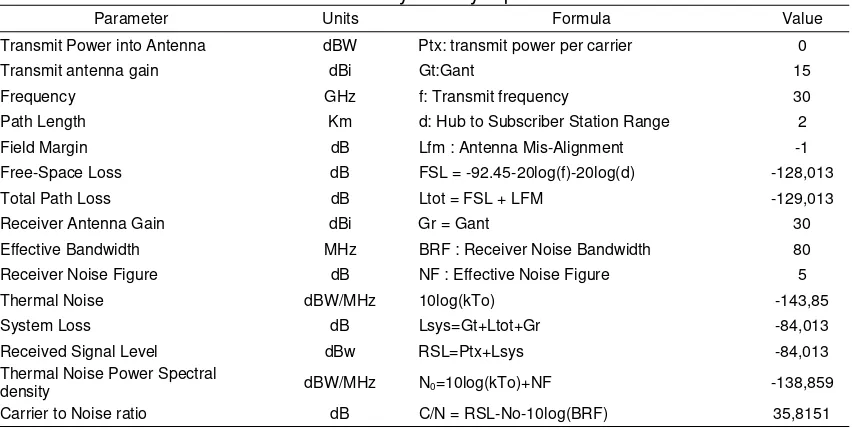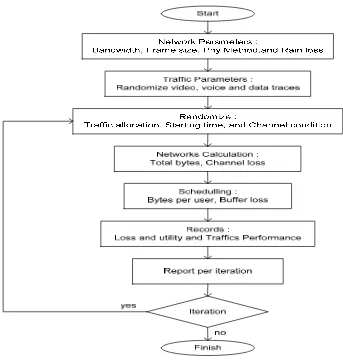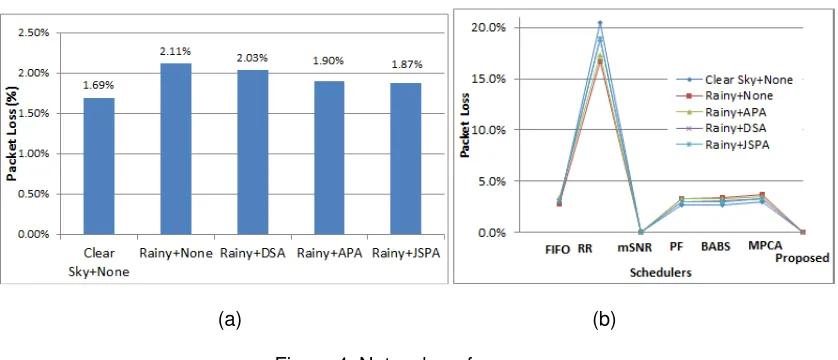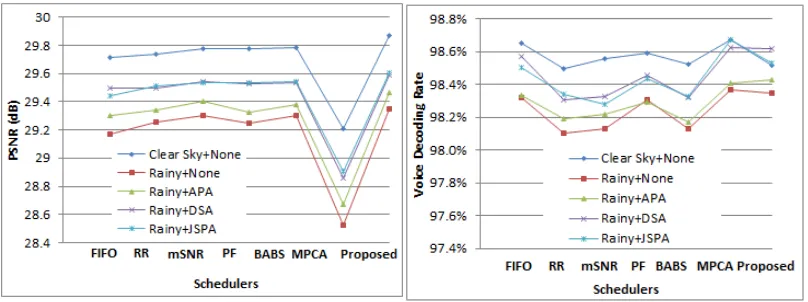DOI: 10.12928/TELKOMNIKA.v13i1.1194 230
Heterogenous Traffic Performances on Local Multipoint
Distribution Service System in Rainy Environment
Naemah Mubarakah*, Suherman, Yulianta Siregar, Arman Sani
Department of Elecrical Engineering, University of Sumatera Utara Medan-Indonesia 20155
*Corresponding author, e-mail:[email protected]
Abstract
Local multipoint distribution service (LMDS) system provides high bitrates services up to 40 Mbps operating in millimeter bands. The radio system can be employed to serve heterogenous traffics in any applications such as video surveillance, public internet hotspots and other services. However, the implementation in tropical area faces transmission problems which degrade signal reception, such as heavy rain. This paper examines the performance of heterogenous traffics in LMDS in a rainy environment. Some techniques to tackle rain ploblems were implemented and the effects were assesed. It was proven that PHY and MAC layers contribute to performances enhancement on rainy environment as long as the system uses the suitable scheduler. A packet-based scheduler was proposed by considering packet impact on quality. The results showed that the proposed technique is able to improve video performance about 0.02% over the maximum signal to noise (mSNR) scheduler, maintain voice decoding rate as well as the priority fair (PF) scheduler and increase data decodibility 0.2%.
Keywords: PHY improvement, heterogenous traffics, scheduling, OFDM, LMDS
1. Introduction
Local multipoint distribution service (LMDS) system offers high data rate connectivity in frequency band 20-40 GHz [1]. The radio system is capable of providing broadband services such as internet hotspots complimenting the existing WiFi networks, public services, audio and digital video broadcasting, video surveillance and other potential services. However, radio propagation in ultra high frequency bands faces serious channel attenuation. The attenuation is worsen when the radio system operating in tropical area which has high rain intensity [2]. Therefore, improvement works are required to enhance the performance.
The existing works on capasity improvements vary from physical (PHY) layer to application layer. OFDM system generates high peak-to-average power ratio (PAPR) and is sensitive to frequency offset [3]. Hence, PHY improvements mainly deal with PAPR reduction as well as frequency offsetting. PAPR reduction falls into three categories [3]: distortion methods by using clipping and filtering, distortionless methods which avoid signal modification through, for instance, proper signal mapping, and coding methods by increasing the signal decodibility. Some techniques deal with frequency offset problem have been highlighted in [4] . One of the proposed techniques to overcome sub-carrier frequency offset is by adaptively distributing the power level among subcarrier. The adaptive power allocation (APA) adjusts the power level on subcarrier frequency based on the expected bit error rate (BER) [5].
The allocation scheme is the main OFDM improvement method locating in medium access (MAC) layer. The allocation scheme includes frequency selection method as well as user scheduling algorithm. Dynamic subcarrier allocation (DSA) technique is one of the frequency allocation methods which dynamically assigns the channel frequency according to the channel state information (CSI) [6] . User schedulers have been intensively proposed by researchers since it is application-dependant. Round robin (RR), first in first out (FIFO) [7], maximum signal to noise (mSNR) [8], and proportional fair (PF) schedulers [9] are user scheduler examples.
TELKOMNIKA ISSN: 1693-6930 231 application layer method. Since these layers solutions are independent of the underlying networks, they are out of the discussion scope.
This paper examines the performances of various traffics on an LMDS system by integrating PHY and MAC layers solutions. The paper also proposes the packet scheduler which is able to differentiate prioritized packets to enhance LMDS system operating in tropical area. In order to simulate the tropical environment, the rain parameters of the selected city: Medan – Indonesia, are included in the evaluation method.
2. Packet-based Scheduler for Heterogenous Traffics
The packet-based scheduler is proposed based on the maximum signal to noise (mSNR) scheduler but has the capability of prioritizing video, voice and data packets among other packets. The mSNR scheduler allocates bandwidth based on PHY property: signal to noise ratio (SNR). The scheduler sorts users based on the quality of their signals. The highest priority belongs to user with the highest SNR. If i,n denotes SNR of i mobile users with n resources, if there are j mobile users at given scheduling time, the the scheduling priority is given by Equation (1) [8]:
The mSNR scheduler does not consider the types of the packets, which potentially reduces the quality of the real-time video and voice. In order to overcome the drawback, the proposed packet-based scheduler ranks the users based on packet types priority order. The priority order follows the following sequence: (i). video packet type I; (ii) video packet type P/B; (iii). higher voice packet size; (iv). higher data packet size; (v). lower voice packet size; (vi). lower data packet size. The priority is applied by sorting the mSNR output in Equation (1), by using Equation (2).
) _ _
(
_mobile Sort Selected mobile mSNR
Selected (2)
The packet priority has been applied in band assignment based on SNR (BABS) scheduler [12]; however, the scheduler sorts mSNR result only based on traffic size. The proposed scheduler also improves frame-based [13] and non-sorting scheduler [14] which are aimed only for video traffic.
3. Research Method
3.1. Rain intensity and loss calculation
Rain causes fading on OFDM system, for instance, rain attenuation reaches 80 dB on 29 GHz OFDM system with 5,7 km link [Salehudin]. Poor rain attenuation makes it is important to measure the intensity and take into calculation. Rain intensity measurement is performed in three different locations in Medan City - Indonesia: Padang Bulan, Polonia and Sampali using Hellman measurement unit [8]. The measured rain intensity is expressed by millimeter per hour (mm/h). The specific path loss A (dB/km) is then calculated by using Equation 3 where R is rain intensity (mm/h):
Figure 1. Rain loss at 30 GHz
3.2. PHY layer model
The physical parameter of the OFDM networks follows specifications described in [17] where related values in Table 1 were used in calculation whenever required.
Table 1. Physical layer parameters
Parameter Units Formula Value
Transmit Power into Antenna dBW Ptx: transmit power per carrier 0
Transmit antenna gain dBi Gt:Gant 15
Frequency GHz f: Transmit frequency 30
Path Length Km d: Hub to Subscriber Station Range 2
Field Margin dB Lfm : Antenna Mis-Alignment -1
Free-Space Loss dB FSL = -92.45-20log(f)-20log(d) -128,013
Total Path Loss dB Ltot = FSL + LFM -129,013
Receiver Antenna Gain dBi Gr = Gant 30
Effective Bandwidth MHz BRF : Receiver Noise Bandwidth 80
Receiver Noise Figure dB NF : Effective Noise Figure 5
Thermal Noise dBW/MHz 10log(kTo) -143,85
System Loss dB Lsys=Gt+Ltot+Gr -84,013
Received Signal Level dBw RSL=Ptx+Lsys -84,013
Thermal Noise Power Spectral
density dBW/MHz N0=10log(kTo)+NF -138,859
Carrier to Noise ratio dB C/N = RSL-No-10log(BRF) 35,8151
3.3. MAC, Network and transport layer models
TELKOMNIKA ISSN: 1693-6930 233
Figure 2. OFDM MAC model
In real world, packet transmissions include original and retransmitted packets. Modelling the situation in simulation results complicated bandwidth calculation. Therefore, this research simplifies the transport layer model by applying User Datagram Protocol (UDP) to all users. This is acceptable as video and voice traffics through the internet are now mostly using UDP.
3.4. Application layer model
The applications or traffics are assumed to be in uplink directions. Traffics include video, voice and data. Video traffics are generated by using their traces which contain numbers of bytes that are transmitted in a specific time. Video traces use akiyo_cif.yuv video traces as used in [14]. The voice traces are taken from an Adaptive Differential Pulse Code Modulation (ADPCM) codes which has 32 kbps rates. The data traffics are generated randomly with random transmission time.
Traffics are generated and randomized with different starting point in the each simulation iteration. Every user generates different traffic in different allocation. By doing this, the randomness of the simulation background is achieved and simulation results are fair enough.
3.5. Simulation Design
Figure 3. Simulation design
Radio timing is divided into small slots and denoted as transmission frames. Traffic traces, rain loss calculations and possible available bandwidth with hundreds iterations for APA method [5], DSA [6] and JSPA [6] optimizations are determined at first place. In each iteration, every node is assigned a traffic trace randomly with random starting time. Base station collects user requests within the same uplink frame. Those requests are then processed based on randomly generated available bandwidth. The allocation is observed using RR, FIFO, PF, mSNR, BABS, maximum proportional rate constraints algorithm (MPCA) [18] and the proposed scheduler. Those allocation is then informed to user through downlink frames. User then transmists bytes according to the allocated bandwidth.
Channel introduces link loss, while base station introduces buffer loss, both losses are recorded. The total of successfully received bytes within the same allocation frame is calculated to determine network utility. Mobile users are set up to 10 nodes and bandwidth 1 MHz is approximated to generate maximum 10 Mbps in clear sky.
3.6. The evaluated parameters
TELKOMNIKA ISSN: 1693-6930 235 contains of I and P frames, where I frames have more significant impacts to video quality rather than P frames, this paper modelled the PSNR calculation by using the following mathematical approximation: maximum PSNR. The same parameters apply for P-frames.
Decoding rates of voice and data traffics are calculated based on the percentage of the successfully received bytes.
4. Results and Analysis
After running a-thousand iterations, recording the received bytes and calculating the network parameters, it is found that rain causes the PSNR performances of video traffics decrease up to 1.7 dB, the voice decoding rates down to about 0.4%, and the data decoding rates are reduced up to 1.3% from clear sky performances. It is also proven that PHY and MAC layers methods such as APA, DSA and JSPA are able to decrease packet loss rates caused by rain loss in different degrees as shown in Figure 4a. Although those methods are not able to achieve clear sky performances; DSA, APA, and JSPA reduce packet loss caused by rain up to 0.08%, 0.21% and 0.24% subsequently.
Even though the PHY methods have positive impacts on the overall performance; the appropriate scheduler selection is important as PHY and MAC layers improvements on rain loss will be insignificant if the chosen scheduler is poor. Figure 4b shows that the DSA, APA, and JSPA methods worsen packet loss when the system employs RR and FIFO schedulers, which are not suitable for heterogenous traffics. The schedulers cause the packet loss dropped up to 21%.
The behavior of the schedulers varies from one to another towards the heterogeneous traffics. As seen on Figure 4b, it could be expected that RR and FIFO result poor traffic performances. However, RR packet loss impact is distributed among video, voice and data as shown in Figure 5. The most affected traffic by the packet loss in RR scheduler is voice which has the lowest decoding rate among other schedulers. The affected traffics by the packet loss in FIFO scheduler are video and data which have the lowest performances among other schedulers.
(a) (b)
Meanwhile, MPCA scheduler behaves contradictively towards heterogenous traffics. MPCA is friendly to voice traffic but not to video and data. Most MPCA packet loss occurs on video and data packets. As the results, PSNR and data decoding rate of MPCA scheduler dropped to about 28.8 dB and 94.3%.
On the other hand, mSNR, PF, BABS and the proposed schedulers show consistent response to heterogenous traffics where video, voice and data have balance performances. The mSNR scheduler for instance, generates 29.5 dB video PSNR in average, almost similar to PF, BABS and the proposed schedulers, without sacrisfying voice and data performances which reached 98.3% and 96,8% decoding rates.
a. video trafiic b. Voice traffic
c. data traffic
Figure 5. Traffic performances
Among the examined schedulers, the proposed packet-based scheduler successfully increases the PSNR performance up to 29.8 dB, in average 0,06 dB higher than mSNR video traffics. The proposed scheduler also maintains voice traffic decoding rates as high as PF scheduler and improves data decoding rates up to 0. 2% higher than mSNR.
6. Conclusion
TELKOMNIKA ISSN: 1693-6930 237 are not friendly to heterogenous traffics. For example, MPCA is suitable for voice but not for video and data.
Scheduler mSNR, PF, BABS, and the proposed one generate balanced traffic performances that are applicable for use in rainy heterogenous traffic environment. The proposed scheduler is able to increase video performance about 0.06 dB over the mSNR scheduler, generates voice decoding rate as good as PF scheduler, and improve data decoding rate 0.2% higher than mSNR.
Since reseach uses UDP in transport layer, various protocol assessment could be of the future works.
References
[1] Jun Y, Zang, Ben Letaief, K. Cross-layer Adaptive Resource Management for Wireless Packet Network with OFDM Signaling. IEEE Transactions on Wireless Communications. 2004; 5(11).
[2] Mubarakah, Naemah, Rika WA, Mulyadi M. Performance of Subcarrier and Power Allocation OFDM on Millimeter Wave. TELKOMNIKA (Telecommunication Computing Electronics and Control). 2013: 167-174.
[3] Juwono, Filbert H, Randy SP, Dadang G. A Study on Peak-to-Average Power Ratio in DWT-OFDM Systems. TELKOMNIKA (Telecommunication Computing Electronics and Control). 2014; 12(5): 3955-3961.
[4] Sari EF. A Model to investigate Performance of Orthogonal Frequency Code Division Multiplexing.
TELKOMNIKA (Telecommunication Computing Electronics and Control). 2012; 10(3).
[5] Naemah M, Soeharwinto, Fakhruddin RB. Optimizing OFDM Downlink Performance on LMDS System. International Journal of Engineering Research & Technology (IJERT). 2013; 2(11).
[6] Mohanram C, Hashyam S. Joint Subcarrier and Power Allocation in Channel-Aware Queue-Aware Scheduling for Multiuser OFDM. IEEE Transaction on Wireless Communications. 2007; 6(9).
[7] Dhrona P, Ali NA, Hassanein H. A performance study of scheduling algorithms in Point-to-Multipoint WiMAX networks. Proc. Local Computer Networks Conference, (Montreal, Que., Oct.). 2008: 843-850.
[8] Choi J. Distributed beamforming using a consensus algorithm for cooperative relay networks.
Communications Letters, IEEE 15.4. 2011: 368-370.
[9] Moulin H. Proportional scheduling, split-proofness, and merge-proofness. Games and Economic Behavior. 2008; 63(2): 567-587.
[10] Suherman S, Al–Akaidi M. An efficient negative acknowledgement–based transport protocol in 802.11 media streaming. International Journal of Ad Hoc and Ubiquitous Computing. 2014; 16(3): 161-171.
[11] Suherman S, Marwan AA. Increasing uplink broadband video streaming protocol performance in WiMAX network. International Journal of Internet Protocol Technology 7.3. 2013: 176-185.
[12] Woo C, Eunsung O, Daesik H. Simple dynamic subcarrier allocation with CQI feedback reduction for OFDMA systems. Vehicular Technology, IEEE Transactions on 57.5. 2008: 3299-3303.
[13] Kang SH, Zakhor A. Packet scheduling algorithm for wireless video streaming. Proc. International Packet Video Workshop, Pittsburgh, PY. 2002.
[14] Suherman, Al-Akaidi M. Adjusting WiMAX for a dedicated surveillance network. International Journal of Electrical and Computer Engineering. 2013; 3(4).
[15] ITU-R. Propagation data and prediction methods required for the design of terrestrial line-of-sight systems. Recommendation ITU-R. 2001; P.530-10.
[16] ITU-R. Specific attenuation model for rain for use in prediction methods. Rec. ITU-R. 1999; P.838-1.
[17] CY Chu, KS Chen. Effects of Rain Fading on the Efficiency of the Ka-Band LMDS System in the Taiwan Area. IEEE Transactions on Vehicular Technology. 2005; 54(1): 9-19.
[18] Yibing L, Xu Z, Fang Y. Improved Dynamic Subcarrier Allocation Scheduling for SC-FDMA Systems.
Journal of Information & Computational Science. 2012; 9(12): 3529–3537.




